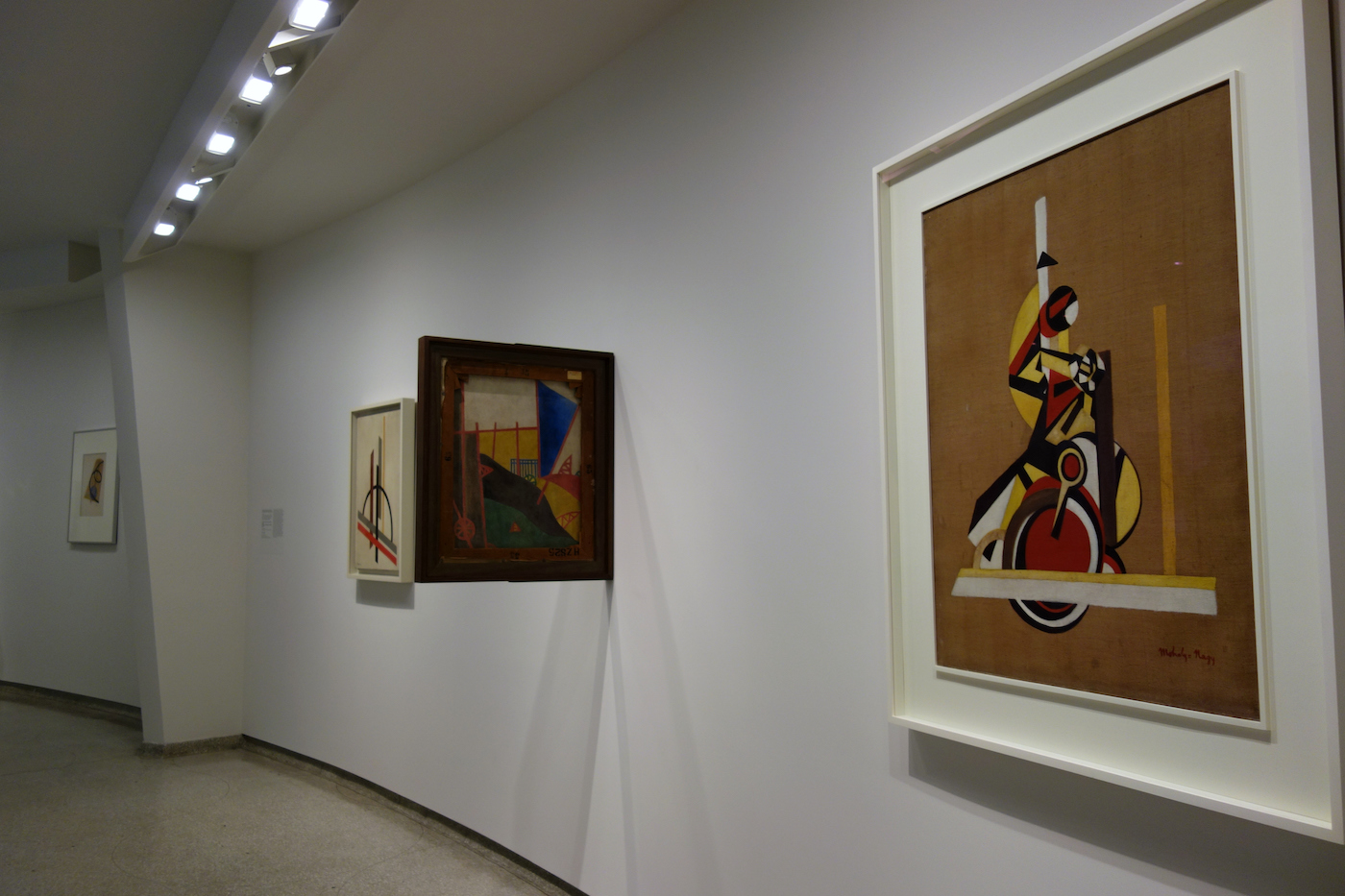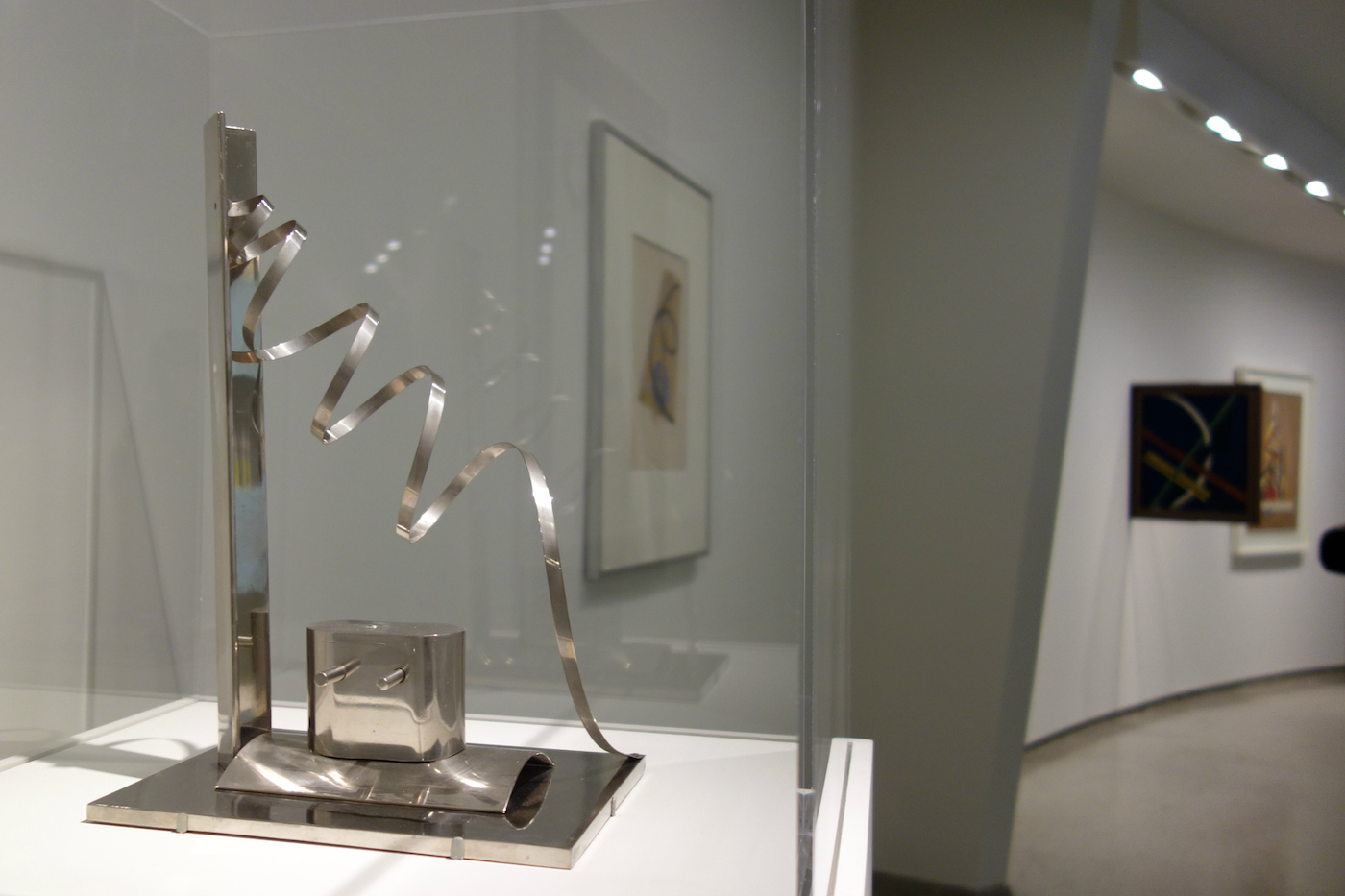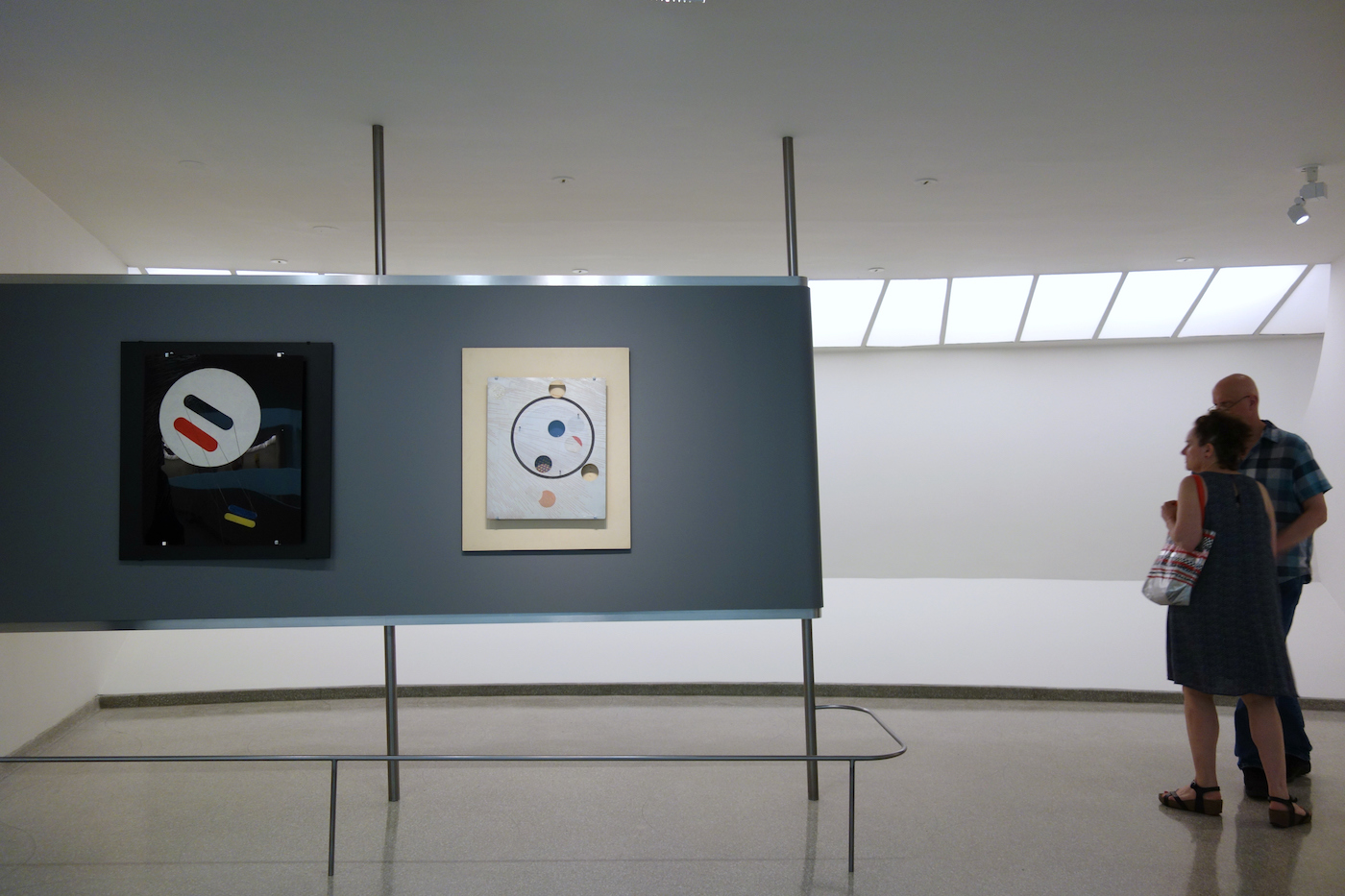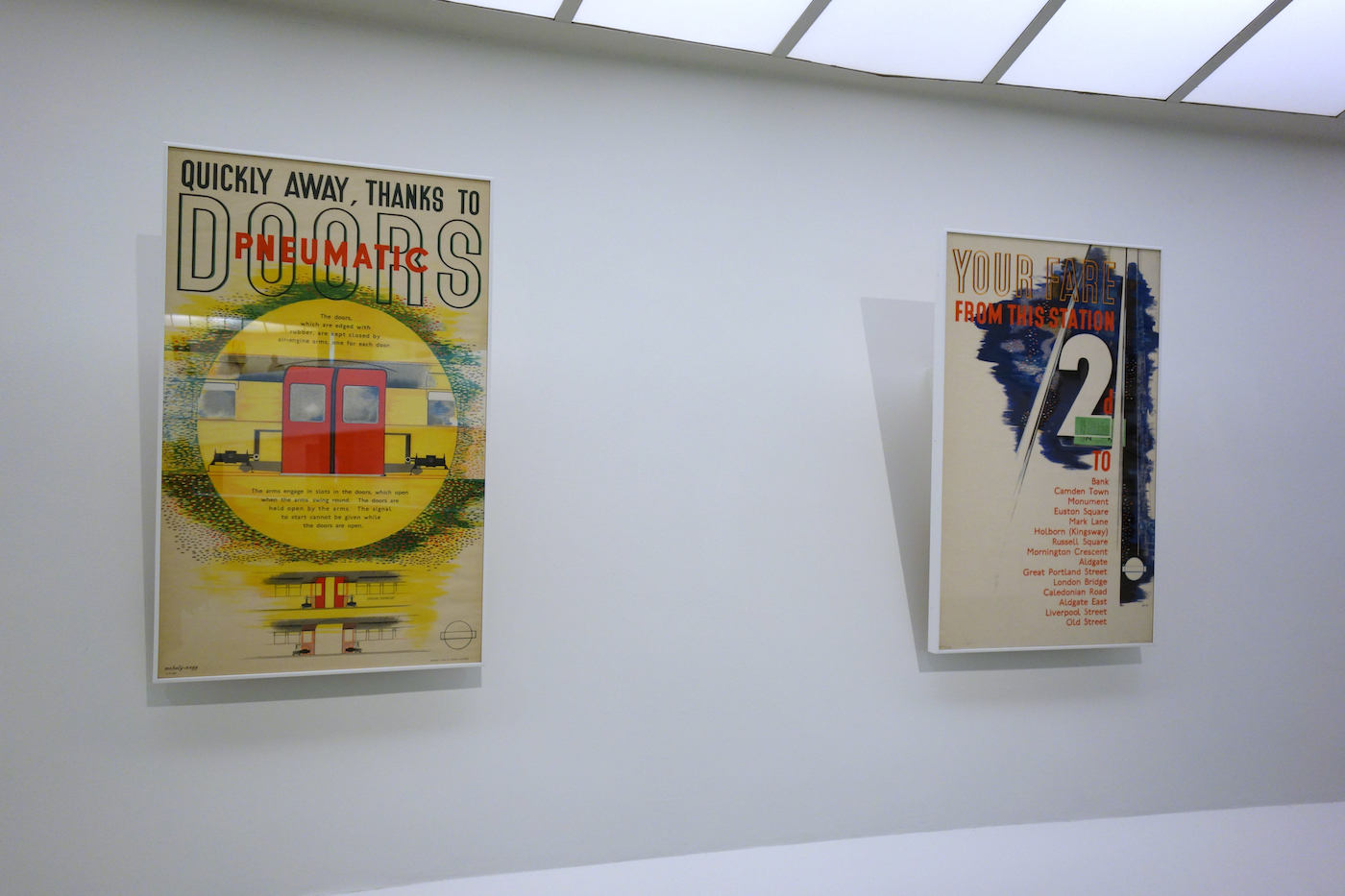
László Moholy-Nagy, “A II (Construction A II)” (1924), oil and graphite on canvas, 45 5/8 x 53 5/8 inches, on view in ‘Moholy-Nagy: Future Present’ at the Guggenheim Museum (all photos by the author for Hyperallergic unless noted)
Decked out in red factory overalls, László Moholy-Nagy cut a striking figure of an avant-garde utopian during his time teaching at the Bauhaus in Dessau from 1923 to 1928. And while his spirited belief in art inspiring a better future could define his career, there was also his radical experimentation with materials. Plexiglas sculptures melted in his own oven, and balanced Constructivist paintings with layers of geometric forms, were in turn influenced by his relocations across Europe and finally to the United States with the rise of the Nazis. And then there was a whole other body of graphic and theatrical design, where he brought his play with collaged imagery into the commercial realm.

László Moholy-Nagy, “Construction AL6 (Konstruktion AL6)” (1933–34), oil and incised lines on aluminum, 60 × 50 cm (courtesy IVAM, Institut Valencià d’Art Modern, Generalitat, © 2016 Hattula Moholy-Nagy/VG Bild-Kunst, Bonn/Artists Rights Society (ARS), New York) (click to enlarge)
Moholy-Nagy: Future Present, which opened this past weekend at the Solomon R. Guggenheim Museum in Manhattan, is organized by the Guggenheim Foundation, the Art Institute of Chicago, and the Los Angeles County Museum of Art (LACMA) as his first retrospective in the United States in half a century. It chronologically crawls up the museum’s central spiral with over 300 pieces, from 1920s abstraction to 1940s “Space Modulators” that cast curious shadows from their plastic forms, some of his final work before his death at the age of 51 in 1946 from leukemia.
One of these sculptures — “Dual Form with Chromium Rods” (1946) — hovers on a wire down into the rotunda, greeting visitors as they begin the ascent on the spiral ramp. It’s not a monumental piece, appearing a bit like an industrial will-o’-the-wisp with its Plexiglas and chrome-plated brass, but with its spindly shadow dancing alongside, it encapsulates many of the ideas behind his work, including the embrace of new materials, light, transparency, and unexpected forms.

László Moholy-Nagy, “Dual Form with Chromium Rods” (1946), Plexiglas and chrome-plated brass, 36 1/2 x 47 7/8 x 22 inches
It’s definitely not an exhibition that feels like a summer blockbuster; he doesn’t have the same high profile as other Bauhaus alumni like Vasily Kandinsky or Josef Albers. Unless you are a hardcore Moholy-Nagy superfan, there likely aren’t any showpieces that you’ll be seeking out, and it’s certainly possible many visitors won’t be familiar with the Hungarian artist’s name (or how to pronounce it; “Mo-holy-Nawdge” is the most accepted). Yet Future Present is a surprisingly accessible and enjoyable exhibition about one man’s continuous experimentation. Whether his “telephone paintings,” which, he explained, were painted at an enamel factory through his called-in instructions, or his camera-less photograms made through exposing the paper to light, each reflects an optimistic embrace of possibility.
One of the standout moments is the 2009 recreation by Kai-Uwe Hemken and Jakob Gebert of his unrealized “Room of the Present,” where among collages of photographs, and a very Bauhaus structure of metal and black walls, is a replica of his “Light Prop for an Electric Stage.” It only operates about 14 times a day, so a bit of serendipity is involved, but when it springs into kinetic action it casts curious shadows as it turns. The contraption of gears, metal, plastic, and wood was built in 1930, and Moholy-Nagy hauled it along as a cumbersome travel companion. Alice Rawsthorn wrote for the New York Times in 2009 that customs officers “snorted in disbelief” when he said it was a machine “to create pools of light and shadow so he could study their movement,” and he was no better off when he lied and claimed it was “a robot, fountain, and mixing machine” (although apparently “hairdressing equipment” did the trick).

László Moholy-Nagy, “Room of the Present (Raum der Gegenwart)” (constructed in 2009 from plans and other documentation dated 1930), mixed media

László Moholy-Nagy, “Light Prop for an Electric Stage” (1930), exhibition replica, constructed in 2006, courtesy of Hattula Moholy-Nagy, metal, plastics, glass, paint, and wood, with electric motor, 59 7/16 x 27 9/16 x 27 9/16 inches
This may be slightly blasphemous to Moholy-Nagy’s impressive legacy, but I personally am most drawn to his advertising work. I’ve previously written about his 1936 design for Imperial Airways, where he morphed the London Underground map into a dynamic cartography for aviation routes, and the exhibition joins this work with examples like his vibrant posters for the Underground, where large typography warned riders of new pneumatic doors and the distance allowed by their fares in the same lively exuberance as his photomontages. His belief in the elevating impact of art on the social consciousness seems to also be behind even these commercial endeavors.
Frank Lloyd Wright’s spiral in the Guggenheim building works for Moholy-Nagy, rather than against the art as has been the case in past Guggenheim exhibitions, allowing his two-dimensional pieces to be embedded in its broad walls. When you look out at the opposite side of the rotunda, the differently colored backs of the ephemera cases and sporadic temporary walls in blueish gray appear together like another version of one of Moholy-Nagy’s paintings. However, I at least found there was some obtrusive glaring on the work due to the lighting, and many of the paintings being behind protective glass.
After Future Present closes in September, it will open on October 2 at the Art Institute of Chicago, and then on February 12, 2017 at LACMA. It’s a very methodical exhibition, presenting these hundreds of examples of his work without weighing one area of his art over another, offering a vision of a modernist who saw a populist potential in art and technology.

László Moholy-Nagy, “Twisted Planes” (1946), Plexiglas and steel, 16 x 34 3/8 x 20 1/8 inches

László Moholy-Nagy, “Photogram” (1926), gelatin silver photogram, 23.8 x 17.8 cm (courtesy Los Angeles County Museum of Art, Ralph M. Parsons Fund, © 2016 Hattula Moholy-Nagy/VG Bild-Kunst, Bonn/Artists Rights Society (ARS), New York, photo by Museum Associates/LACMA)

Installation view of ‘Moholy-Nagy: Future Present’

Installation view of ‘Moholy-Nagy: Future Present’ at the Guggenheim Museum

László Moholy-Nagy, “A 19” (1927), oil and graphite on canvas, 80 × 95.5 cm (courtesy Hattula Moholy-Nagy, © 2016 Hattula Moholy-Nagy/VG Bild-Kunst, Bonn/Artists Rights Society (ARS), New York)

László Moholy-Nagy, “Nickelplastik mit Spirale (Nickel Sculpture with Spiral)” (1921), nickel-plated iron, welded, 14 1/8 x 6 7/8 x 9 3/8 inches

László Moholy-Nagy, “Vertical Black, Red, Blue” (1945), oil and incised lines on Plexiglas on original base; László Moholy-Nagy, “Twisted Planes” (1946), Plexiglas and steel

László Moholy-Nagy, “B-10 Space Modulator” (1942), oil and incised lines on Plexiglas, in original frame, 16 7/8 x 11 1/2 x 2 3/8 inches

László Moholy-Nagy, “Space Modulator CH for Y” (1942), oil and incised lines on Formica, 60 5/8 x 23 13/16 inches; “Space Modulator CH for R1” (1942), oil and incised lines on Formica, 62 3/16 x 25 9/16 inches

László Moholy-Nagy, “Space Modulator” (1938-40), oil and graphite pencil on linen, 47 x 47 inches

Installation view of ‘Moholy-Nagy: Future Present’

Installation view of ‘Moholy-Nagy: Future Present’

László Moholy-Nagy, “Nuclear II” (1946), oil and graphite on canvas, 49 3/4 x 49 3/4 inches ; “Nuclear I CH” (1945), oil and graphite on canvas, 38 x 30 inches

László Moholy-Nagy, “CH Space 5” (1941), oil and graphite on burlap, 47 1/4 x 47 1/4 inches; “CH BEATA I” (1939), oil and graphite on canvas, 46 7/8 x 47 1/8 inches

Installation view of ‘Moholy-Nagy: Future Present’

1930s advertising design by László Moholy-Nagy(

Installation view of two advertisements for the London Underground by László Moholy-Nagy from 1936 and 1937

Installation view of ‘Moholy-Nagy: Future Present’

László Moholy-Nagy, “T1” (1926), oil, sprayed paint, incised lines, and paper on Trolit, 55 1/16 x 24 5/16 inches

Installation view of ‘Moholy-Nagy: Future Present’

Installation view of ‘Moholy-Nagy: Future Present,’ with photograms from the 1920s at right

Installation view of ‘Moholy-Nagy: Future Present’
Moholy-Nagy: Future Present continues through September 7 at the Solomon R. Guggenheim Museum (1071 Fifth Avenue, Upper East Side, Manhattan).

No hay comentarios:
Publicar un comentario